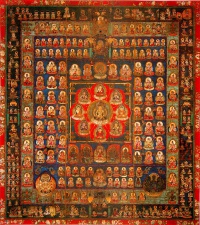Dhatu: Unterschied zwischen den Versionen
Aus Spiritwiki
Adm1 (Diskussion | Beiträge) |
Admdb1 (Diskussion | Beiträge) K (Textersetzung - „<historylink type="back" style="font-family: Arial, Helvetica, sans-serif; font-size: 14px; color: #ffffff; padding: 4px 8px; float:right; background: -moz-linear-gradient( top, #fcf9fc 0%, #6a75eb); background: -webkit-gradient( linear, left top, left bottom, from(#fcf9fc), to(#6a75eb)); -moz-border-radius: 30px; -webkit-border-radius: 30px; border-radius: 30px; border: 3px solid #ffffff; -moz-box-shadow: 0px 3px 11px rgba(240,237,240,0.5), inset 0px 0px 1px rgba(000,145,255,1); -webkit-box-shadow: 0px 3px 11px rgba(240,237,240,0.5), inset 0px 0px 1px rgba(000,145,255,1); box-shadow: 0px 3px 11px rgba(240,237,240,0.5), inset 0px 0px 1px rgba(000,145,255,1); text-shadow: 0px -1px 0px rgba(000,000,000,0.2), 0px 1px 0px) |
||
| Zeile 28: | Zeile 28: | ||
== Weblinks == | == Weblinks == | ||
* [//www.wisdomlib.org/buddhism/book/guide-to-tipitaka/d/doc3498.html guide-to-tipitaka : Datukatha] | * [//www.wisdomlib.org/buddhism/book/guide-to-tipitaka/d/doc3498.html guide-to-tipitaka : Datukatha] | ||
<br> < | <br> <historylink> | ||
[[Kategorie:Buddhismus]] | [[Kategorie:Buddhismus]] | ||
[[Kategorie:Vajrayana]] | [[Kategorie:Vajrayana]] | ||
Version vom 11. Dezember 2017, 22:35 Uhr
Dhatu oder die 18 Elemente sind ein Begriff für die Bedingungen von Wahrnehmung und Bewusstseinsvorgängen.
Sie werden im Buch Dhatukatha(Diskussion der Elemente) des Abhidhammapitaka ausführlich behandelt und stehen in Zusammenhang mit der Lehre vom bedingten Entstehen (Paticcasamuppāda), insbesondere von den sechs Bereichen (Sans. Ṣaḍāyatana, Pali Saḷāyatana) und der Lehre von den 5 Skandhas.
Spezielle Dhatus sind
- Tathagatagarbha oder Buddha-dhatu
- Dharmadhatu
- Vajradhatu
- Garbhadhatu
- Raum-Element (Akasa-dhatu), in dem die Form der Leere als 'reines Atom'(suddhanu) erscheint, das aber nicht von der Natur des 'paramanu' sondern der 12 Bodhisattva - Bhumis ist[1]
- Ārūpyadhātu (Formlose Bereiche)
- Arupa Bhumi (Arūpaloka, Arupachara Brahmalokas oder nichtmaterielle formlose Brahma - Bereiche)
- Rūpadhātu (Rūpaloka, Bereich der Form)
- Kāmadhātu (Kāmaloka, Bereich der Wünsche)[2] ; Mara in Tushita
Letztere drei Bereiche werden als Trailokya (Skt. triloka oder tridhātu, Pali: tiloka, Wylie: khams gsum) bezeichnet.
Literatur
Referenzen
- ↑ https://books.google.de/books?id=i_KOOn0BaCoC&pg=PA68&lpg=PA68&dq=suddhanu The Inner Kalacakratantra]: A Buddhist Tantric View of the Individual, Vesna Wallace, S. 68
- ↑ http://www.rigpawiki.org/index.php?title=Six_heavens_of_the_desire_realm
Siehe auch
- Tathagatagarbha oder Buddha - Natur (skt. buddha-dhātu, tathāgata-dhātu; auch : Buddhata)
Weblinks
<historylink>
